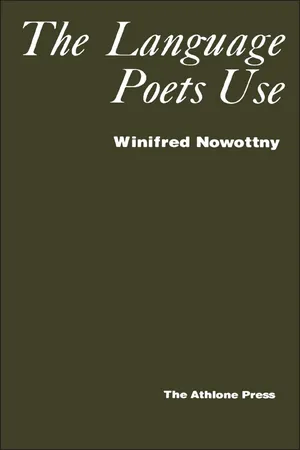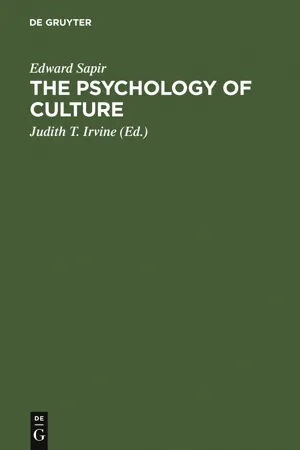Literature
Symbolism
Symbolism in literature refers to the use of symbols to represent ideas, emotions, or qualities. These symbols can be objects, characters, or actions that carry deeper meanings beyond their literal interpretation. By using symbolism, writers can convey complex themes and concepts in a more evocative and layered manner, inviting readers to engage with the text on a deeper level.
Written by Perlego with AI-assistance
3 Key excerpts on "Symbolism"
- eBook - PDF
- Winifred Nowottny(Author)
- 2000(Publication Date)
- The Athlone Press(Publisher)
VIII Symbolism and Obscurity AT an extreme point of differentiation from ordinary uses of language stands the language of what it has become customary to call 'symbo-lism'. * That's the trouble with poems . . . they may be merely symbolic and mean nothing.' 1 The opposite view—that Symbolism purveys a purer intuition of a higher or more important kind of reality and uses words not less but more meaningfully than is usual— may be represented by the words of Jean-Paul Sartre: The poet is outside of language. He sees words inside out as if he did not share the human condition, and as if he were first meeting the word as a barrier as he comes towards men. Instead of first knowing things by their name, it seems that first he has a silent contact with them, since, turning toward that other species of thing which for him is the word, touching them, testing them, palping them, he discovers in them a slight luminosity of their own and particular affinities with the earth, the sky, the water, and all created things. 2 The claim that Symbolism takes us (albeit by some means not clearly defined) to a sphere of knowledge above the ordinary is made by Helen Dunbar 3 in a different way when she says that a symbol 'is an expression of meaningful experience having basis in association' (p. 10), that it is 'unique in its power to give perspective of relation-ships' (p. 18), and that—in the words she quotes (p. 13) from J. H. van der Hoop's Character and the Unconscious [trans. Elizabeth Trevelyan (London, 1923), p. 119]—'symbols are the chief means by which the human mind expresses, not so much those ideas which it has outgrown, or wishes to conceal, but those which it has not yet mastered'. Even this handful of citations from various writers on 1 Quoted from D. J. Enright's Insufficient Poppy (London, 1960) by John Coleman, in a review in The Spectator, 5 August 1960, p. 222. * Quoted from Sartre's What is Literature? trans. - eBook - PDF
- Edward Sapir, Judith T. Irvine(Authors)
- 2011(Publication Date)
- De Gruyter Mouton(Publisher)
In its original sense it was restricted to objects or marks intended to recall, represent, or direct special attention to some larger and more complex phenomenon — [some] person, object, idea, event or projected activity associated only vaguely or not at all with the symbol in any natural sense. By gradual extensions of meaning the terms symbol and Symbolism have come to include not merely such trivial objects and marks as the letter t [to indicate a particular sound in speech], black balls, to indicate a negative attitude in voting, and stars and daggers, to remind the reader that supplementary information is to be found at the bottom of the page, but also more elaborate objects and devices, such as flags and signal lights, which are not ordinarily regarded as important in themselves but which point to ideas and actions of great consequence to society. Such complex systems of reference as speech, writing and mathematical notation should also be included under the term symbol-ism, for the sounds and marks used therein obviously have no meaning in themselves and can have significance only for those who know how to interpret them in terms of that to which they refer. 24 A certain kind of poetry is called symbolic or symbolistic because its apparent content is only a suggestion for wider meanings. In personal relations too there is much behavior that may be called symbolic, as when a ceremonious bow is directed not so much to an actual person as to a status which that person happens to fill. The psychoanalysts have come to apply the term symbolic to almost any emotionally charged pattern of behavior which has the function of unconscious fulfillment of a repressed ten-dency, 25 as when a person assumes a raised voice of protest to a perfectly 232 Symbolic Structures and Experience (1933 — 34) indifferent stranger who unconsciously recalls his father and awakens the repressed attitude of hostility toward the father. - Seung-In Song(Author)
- 2019(Publication Date)
- Peter Lang Group(Publisher)
4 Symbolism in Johannine Literature Understanding Symbolism is not an easy task. Regarding this difficulty David W. Wead states: Symbolism within the Gospel of John must be approached with extreme caution. Not only is there very little agreement as to what should be considered Symbolism but also there are many other good reasons why the search for the symbolic interpretation brings trouble to the exegete. 1 As Wead points out, scholars often have different opinions on Symbolism. This diversity seems to result from different definitions, different methods to identify symbol, and different classifications. Thus, this chapter has two purposes: (1) to define Symbolism as used in this dissertation and (2) to see how many and what kind of symbols are used in the Johannine literature, especially in the Gospel. Since Symbolism in the Epistles is not as an important feature as in the Gospel or Revelation, 2 we will focus on the Gospel and Revelation. The Definition and Nature of Symbol For the purpose of this dissertation the following basic and simple definition of symbol will be used: “an image, a word, an action, or a person that stands for 46 | Water as an Image of the Spirit in the Johannine Literature something or someone other than itself.” Scholars often provide somewhat differ- ing definitions.
Index pages curate the most relevant extracts from our library of academic textbooks. They’ve been created using an in-house natural language model (NLM), each adding context and meaning to key research topics.


